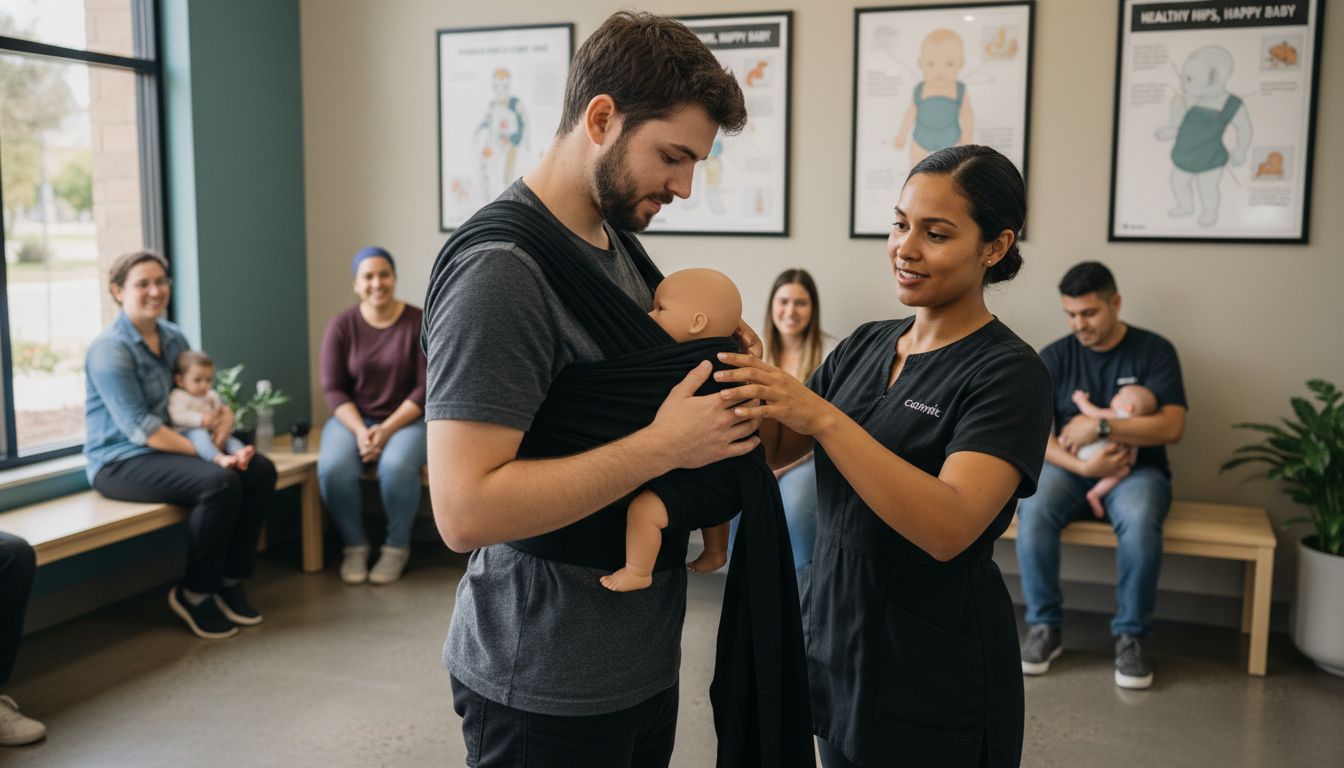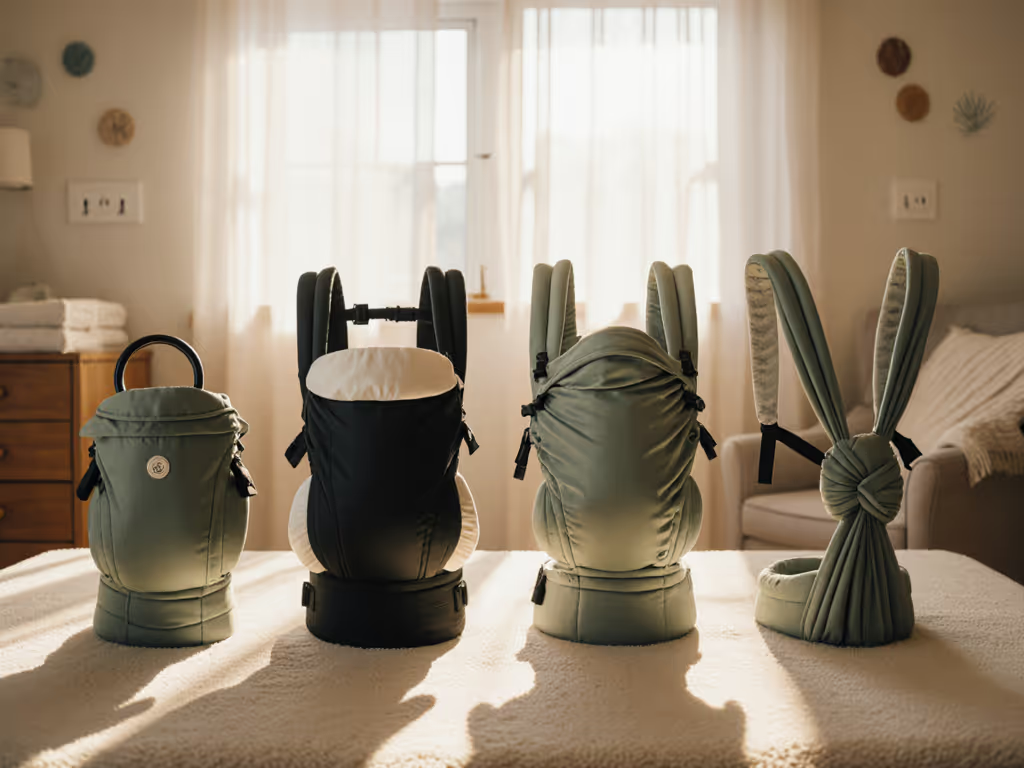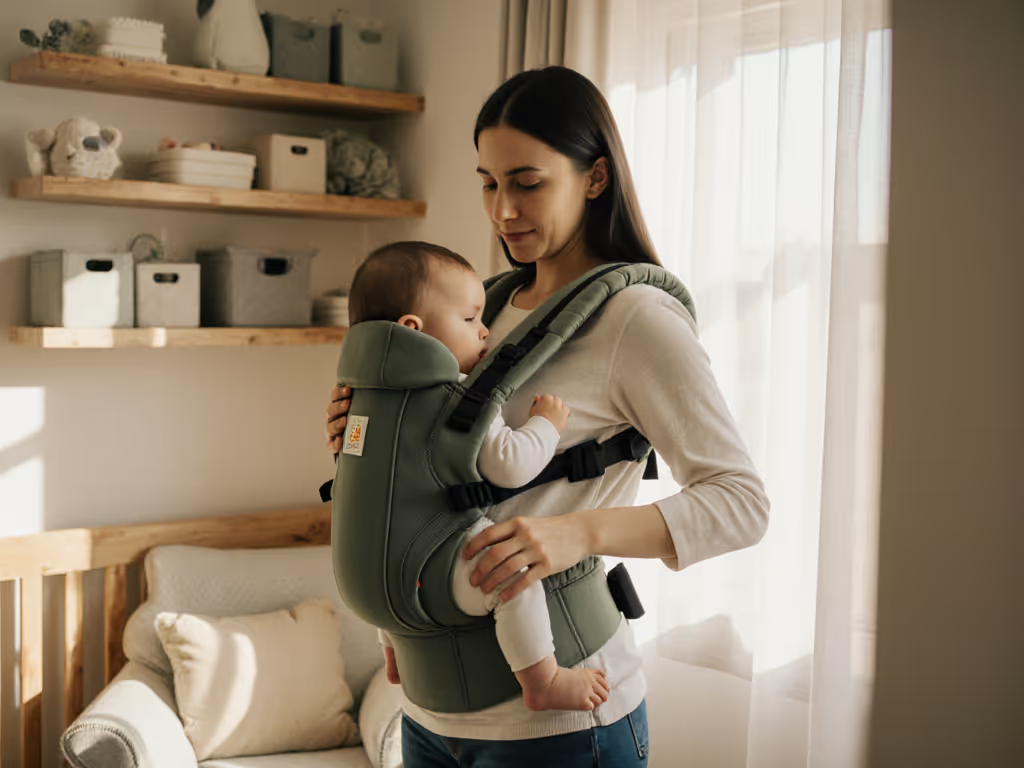
Avoid Common Babywearing Mistakes: Complete Guide

Nearly 90 percent of new parents admit they feel uncertain about safe babywearing in the first months. For families, keeping a baby close—while protecting delicate hips and spines—can seem confusing at first. The right guidance makes all the difference, helping you move beyond guesswork and toward confidence, comfort, and security. This guide unpacks what really matters for safe and effective babywearing, so you can support healthy development and build stronger bonds.
Key Takeaways
| Point | Details |
|---|---|
| Safe Babywearing | Proper positioning and carrier selection are crucial for protecting your baby's spine, hips, and airway during babywearing. |
| Carrier Types | Understanding the differences between wraps, slings, mei tais, and structured carriers helps caregivers choose the safest and most comfortable option for their needs. |
| Proper Positioning | Maintaining the 'M' or 'frog-leg' position promotes healthy spinal and hip development, along with ensuring the baby's airway is clear. |
| Safety Checks | Regularly inspect the carrier and monitor the baby's comfort and alignment to prevent potential safety errors and enhance the babywearing experience. |
Defining Safe and Effective Babywearing
Babywearing is more than just carrying your infant close - it's a nurturing practice that supports physical, emotional, and developmental bonding between caregiver and child. Safe babywearing requires understanding specific positioning techniques, carrier selections, and body mechanics that protect your baby's delicate spine, hip alignment, and respiratory pathways.
At its core, effective babywearing involves three critical components: proper carrier selection, correct positioning, and constant awareness of your baby's comfort and safety. This means selecting a carrier that provides adequate neck and hip support, maintains your baby's natural anatomical positioning, and allows for easy breathing and movement. The wrong carrier or incorrect usage can potentially compromise your infant's developing musculoskeletal system.
Key principles of safe babywearing include maintaining an "M" shaped leg position for your baby, ensuring their airways remain clear, and positioning them high enough on your body to monitor their breathing and facial expressions. Infant ergonomics play a crucial role - your carrier should support your baby's natural curved spine, allow their legs to spread in a "frog-like" position, and prevent uncomfortable or potentially harmful positioning. Parents should also be mindful of temperature regulation, ensuring neither they nor the baby become overheated during wearing.
Babywearing isn't just about physical proximity - it's a dynamic interaction that supports infant neurological development, provides sensory stimulation, and creates a secure attachment environment. By understanding these fundamental safety principles, caregivers can transform babywearing from a simple transportation method into a profound bonding experience that supports healthy physical and emotional growth.

Types of Baby Carriers and Their Differences
Baby carriers are not a one-size-fits-all solution, with each type offering unique benefits and challenges for caregivers. Research from hip dysplasia specialists reveals that carrier design significantly impacts infant positioning, comfort, and potential musculoskeletal development. Understanding the nuanced differences between carrier types can help parents make informed decisions that prioritize both caregiver convenience and infant safety.
The primary carrier categories include wraps, slings, mei tais, and structured carriers, each with distinct mechanical characteristics.
Here's a comparison of the main baby carrier types and their key characteristics:
| Carrier Type | Support & Ergonomics | Ease of Use | Best For |
|---|---|---|---|
| Wrap | High neck & hip support<br>Custom fit | Moderate<br>Requires practice | Newborns<br>Skin-to-skin contact |
| Sling | Adjustable support<br>One-shoulder fit | Easy<br>Quick to put on | Infants<br>Short trips |
| Mei Tai | Good hip support<br>Structured seat | Moderate<br>Tied straps | All ages<br>Versatile carrying |
| Structured Carrier | Consistent support<br>Padded straps | Easy<br>Auto buckles | Older babies<br>Long outings |
Physiological research comparing carrier types highlights critical ergonomic considerations. A PubMed study examining electromyography data revealed significant differences in caregiver shoulder pressure and heart rate across carrier designs. Structured carriers consistently demonstrated more balanced weight distribution, reducing physical strain during extended wearing periods. However, the same research emphasized that proper fit and individual body mechanics matter as much as carrier type - no single design works perfectly for every caregiver-infant pair.
Beyond mechanical differences, carrier selection should consider practical factors like infant age, caregiver body type, climate, and intended use. Newborns require more supportive, close-contact options that maintain their natural curved spine position, while older infants might benefit from carriers allowing more movement and outward exploration. The ideal carrier adapts to changing developmental stages, provides consistent safety, and feels comfortable for both caregiver and child - transforming babywearing from a functional task into an intimate bonding experience.

Essential Steps for Proper Baby Positioning
Proper baby positioning is the cornerstone of safe and comfortable babywearing, requiring careful attention to your infant's physical alignment, breathing capabilities, and overall support. Ergonomic positioning goes far beyond simply placing your baby in a carrier - it involves creating a supportive environment that mimics the natural curvature of their developing spine and promotes healthy hip development.
The fundamental principle of safe positioning centers on the "M" or "frog-leg" configuration, where your baby's knees are spread wide and sit higher than their bottom, creating a natural, anatomically correct stance. Spine alignment is critical during this process. Your carrier should support the baby's natural curved spine, preventing straightening or unnecessary tension. This means ensuring your infant's head is high enough to kiss, with their chin off their chest to maintain an open airway - a key safety consideration that prevents potential respiratory restrictions.
Key positioning steps include carefully checking your baby's posture from head to toe. Their head should be supported, neck aligned, and breathing unobstructed. The carrier should hold them snugly against your body, eliminating gaps that could cause slipping or improper support. Weight distribution matters immensely - your baby's weight should be centered and close to your body, with their legs in a spread-squat position that promotes healthy hip joint development. Parents should periodically check and readjust positioning, watching for signs of discomfort or potential misalignment.
Babywearing is an intimate dance of connection and support. By mastering these positioning techniques, caregivers transform a simple carrying method into a nurturing experience that supports physical development, emotional bonding, and mutual comfort. Remember that each baby is unique - what works perfectly for one might require slight adjustments for another. Patience, practice, and attentive observation are your greatest tools in achieving safe, comfortable babywearing.
Recognizing and Preventing Safety Errors
Safety in babywearing is not about perfection, but about consistent, mindful practices that protect your infant's most vulnerable developmental stages. Safety errors can emerge from seemingly innocent mistakes - a slightly misaligned carrier, an overlooked fabric fold, or an inadvertently blocked airway can quickly transform a nurturing experience into a potential risk scenario.
Experts identify several critical safety checkpoints that every caregiver must master. Airway protection stands as the most crucial consideration - your baby's face must remain uncovered, with a clear line of sight and unobstructed breathing. This means positioning them high enough to easily kiss their forehead, ensuring their chin doesn't rest against their chest, which can compress their airway. Additionally, regular visual and physical checks are essential: periodically verify that your baby maintains proper spine alignment, their legs are in the "M" position, and no fabric creates unnecessary pressure or potential breathing restrictions.
Prevention strategies require a proactive approach. Always inspect your carrier before each use, checking for wear, loose threads, or structural weaknesses that could compromise safety. Temperature management is another often-overlooked safety component - overheating can occur quickly in close-contact carrying, so dress your baby in lightweight, breathable layers and monitor their comfort level. Be especially vigilant during the first months when infants cannot self-regulate their body temperature effectively. Experienced caregivers recommend a simple "two-finger" test: if you can comfortably place two fingers between your baby and the carrier, the fit is likely appropriate.
Ultimately, safety in babywearing is a dynamic, learning process. No caregiver becomes an expert overnight, and each carrying session offers an opportunity to refine your technique. Trust your instincts, remain observant, and never hesitate to adjust or stop wearing if something feels uncomfortable. By maintaining a vigilant yet relaxed approach, you transform potential safety risks into moments of secure, nurturing connection with your child.
Troubleshooting Fit, Comfort, and Usage Issues
Babywearing challenges are universal, affecting even the most experienced caregivers. Fit issues can transform what should be a comfortable, intimate experience into a frustrating ordeal, making it crucial to understand and quickly address common problems that arise during carrier use. Recognizing the early signs of discomfort or misalignment can prevent potential safety risks and ensure a more enjoyable babywearing journey.
The most frequent fit complications stem from improper carrier adjustment and body mechanics. Weight distribution plays a critical role - an improperly adjusted carrier can create undue strain on your shoulders, back, and neck. Caregivers should focus on centering the baby's weight, ensuring the carrier's waistband sits at your natural waist, and the shoulder straps distribute pressure evenly. Watch for warning signs like shoulder pain, lower back discomfort, or feeling like you're constantly readjusting the carrier. These symptoms often indicate that your current carrying technique needs refinement.
Temperature and fabric interaction present another set of potential challenges. Breathability becomes crucial, especially during warmer seasons or extended wearing periods. Some carriers trap heat more effectively than others, potentially causing discomfort for both caregiver and infant. Look for signs of overheating like excessive sweating, flushed skin, or increased fussiness. Strategic layering, choosing carriers with moisture-wicking properties, and taking occasional breaks can help mitigate these issues. Additionally, pay attention to fabric tension - too tight can restrict movement, while too loose compromises safety and comfort.
Successful troubleshooting requires patience, practice, and a willingness to experiment. Every caregiver-infant pair is unique, and what works perfectly for one might require slight adjustments for another. Don't get discouraged by initial challenges - they're part of the learning process. Seek advice from experienced babywearing communities, attend local workshops, or consult with professionals who can provide personalized guidance. Remember, mastering babywearing is a skill that develops over time, with each wearing session bringing you closer to finding your perfect carrying rhythm.
Master Safe Babywearing Today for You and Your Baby
The article highlights common mistakes in babywearing that can undermine your baby's comfort and safety. You might feel overwhelmed trying to balance proper positioning, carrier selection, and ensuring clear airways while managing your own comfort. These challenges—like achieving the vital "M" shaped leg position and avoiding airway obstruction—are not easy but are essential for safe bonding. Your goal is to build confidence and peace of mind while carrying your infant in a way that supports healthy development and nurtures your connection.
Take the next step by visiting Caregiver Carry, a trusted resource dedicated to helping you avoid those common babywearing errors. Our site offers detailed guides, evidence-based safety tips, and independent carrier reviews to help you find the perfect fit for your unique needs. Don’t let uncertainty hold you back from enjoying babywearing safely. Explore our complete guides and safety checklists now and equip yourself to create a comfortable and secure carrying experience that benefits both you and your baby.
Frequently Asked Questions
What are the key principles of safe babywearing?
Safe babywearing involves proper carrier selection, correct positioning, and constant awareness of your baby's comfort and safety. Key principles include maintaining an 'M' shaped leg position, ensuring clear airways, and positioning the baby high enough to monitor their breathing.
How do I choose the right type of baby carrier?
Choosing the right carrier depends on your baby's age, size, and your comfort. Options include wraps, slings, mei tais, and structured carriers, each offering distinct benefits in terms of support and ease of use.
What is the importance of proper baby positioning in carrier?
Proper baby positioning is crucial for supporting your infant's developing spine and hip alignment. The ideal positioning follows an 'M' or 'frog-leg' configuration to promote healthy posture and breathing, ensuring the baby feels secure and comfortable.
How can I prevent safety errors while babywearing?
To prevent safety errors, regularly check your baby's airway, ensure the carrier is correctly adjusted, and monitor for any discomfort signs. Always inspect the carrier for wear and choose breathable clothing to avoid overheating during use.



